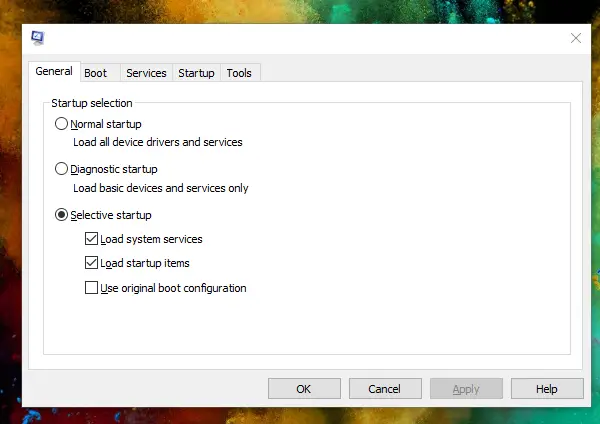What is MSConfig in Windows 11/10
MSCONFIG or System Configuration utility helps users troubleshoot Windows Startup issues. It allows you to manage startup selection, Safe Boot, enable or disable Windows Services, find & launch system tools like Performance Monitor, Resource Monitor, and more. The System Configuration utility is more of a diagnostics tool and offers some great controls for configuring the startup of your system.
How to open MSConfig utility
Open Run Prompt (Win+R), and type msconfig. and press the Enter key. It will launch the System Configuration utility. It will display five tabs:
General: Allows you to boot Windows in diagnostic or selective mode when necessaryBoot: Manage everything related to Windows boot, including Safe mode.Services: Enable or disable Windows and other servicesStartup: The startup section is now managed via Task Manager.Tools: Launch popular System services from here.
Let us take a look at the features in detail.
1] General/Startup Selection
There are three types of Startup selection. The first is the Normal boot where there is almost no restriction on what ads to the boot process. The second is Diagnostic, which is useful to troubleshoot with minimal service while Selective is where you decide what starts with Windows 11/10.
Normal—Boots the system without any diagnostic services. If you are trying to diagnose a problem, you should select one of the other two options. When you are sure the issue is resolved, click this setting to boot your system normally again.Diagnostic — This will make sure Windows boots with essential services and drivers enough to start the computer. It helps you to make sure to find out notorious third-party services and software causing the problem.Selective —Use this section to speed up computer startup. You can choose to disable services and programs which need not start with Windows.
The Selective Startup mode not only allows you to start your system with essential services and drivers (just like diagnostic), but it also allows you to correctly configure the use of additional services and startup applications so you can slowly determine what is causing the problem in your boot process. You can go through and turn on items one at a time from the Service or Startup tabs and see how your system reacts when you reboot. Read: How to remove disabled items from the MSConfig startup list.
2] Boot Options
The options for Safe Boot are: The other options are: Read: What are Boot Advanced Options in MSCONFIG?
3] Services
If you believe that any of the Windows Services is causing an issue, then this section lets you deselect, and help you figure. It lists all the services which start with the boot. You can also uncheck the checkbox to prevent that service from starting up the next time you boot the system. When you choose to deselect services, the startup mode will change to Selective Startup. To make sure not to disable any of the Windows system services, check the box to select hide services in Windows. Be careful when you decide to disable a service because you might cause other problems while attempting to search for the one causing your original problem. Some services are compulsory for your system to operate correctly. Other services, if disabled, may throw off your diagnostic approach because you may be affecting other aspects of your OS. In other words, know why you are disabling a service before you do it, and understand how that service may impact other services or features of your system. TIP: Autostart Explorer lets you explore EVEN the most obscure start up locations.
4] Startup
In Windows 10, the section to manage Startup items is now available with the Task Manager. You can choose to enable or disable applications to start with Windows. I use it to make certain applications that register themselves to start with Windows can be removed. It improved my overall boot timing.
5] Tools
The Tools tab provides a list of diagnostic and informational tools and shows the location of these tools. From within this tab, you can literally “Launch” any system tool, or you can note the location or name of the tool itself. What’s great about this is that it’s a central location to all sorts of tools and even a few preconfigured command-line options. E.g: That said if you want to disable specific applications in the Startup menu, such as certain spyware and malware applications you find, then you should try the MSCONFIG Cleanup tool. It can also help you get rid of its entry from the Registry and remove these items. Read next:
Accidentally disabled all Services in MSCONFIGUse MSConfig to launch Windows tools like System Restore, Regedit, etc.
